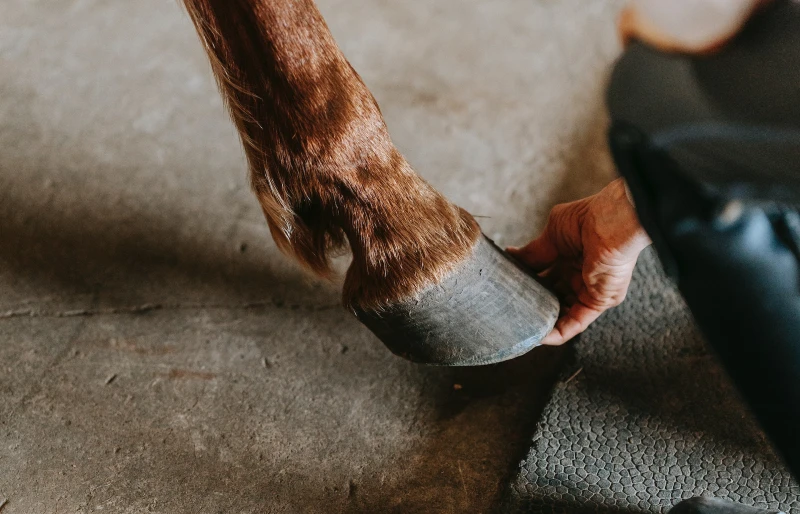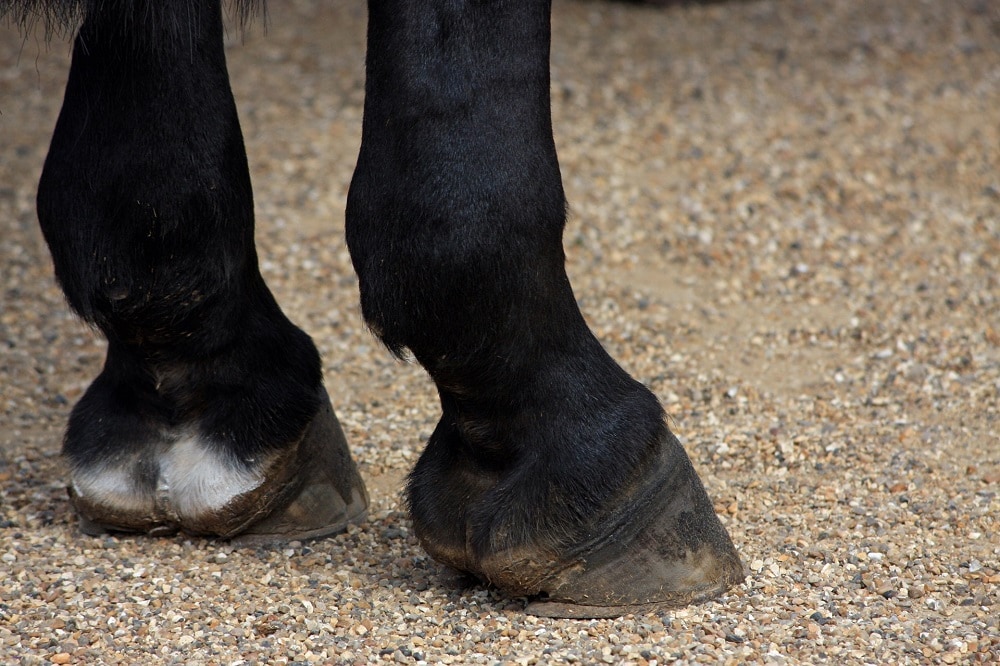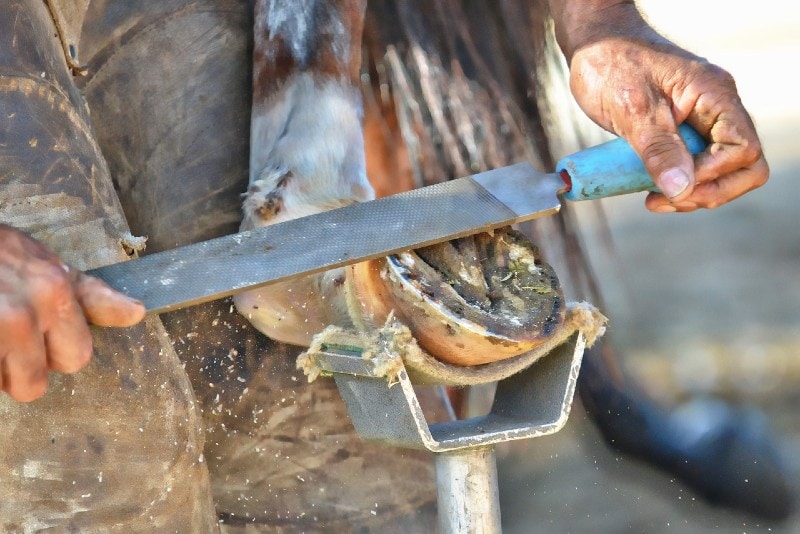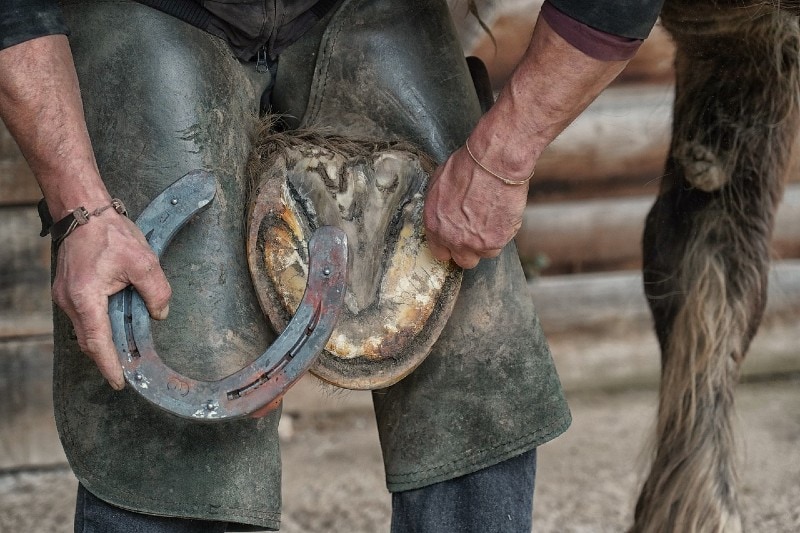
Click to Skip Ahead
Thrush. It’s a short enough word, but it’s enough to strike fear into experienced horse owners’ hearts. What is this common equine condition, and what can you do if your vet or farrier tells you your horse has it?
Let’s look at the potential causes of thrush, what part of the hoof it affects, and what you can do to treat and prevent it.
A Brief Anatomy of the Hoof
Before we get into the details of thrush, let’s go over the anatomy of a horse hoof. Your horse’s hooves have to support a great deal of weight, so trauma or damage to any part of the hoof can be detrimental.
There’s quite a bit more to the hoof, but that should get us started for our discussion of thrush.

What Is Thrush?
Thrush is degeneration of the frog, usually along the sulci. It has a strong smell caused by anaerobic bacteria and sometimes fungi. These bacteria thrive in a poor oxygen environment, like mud.
Typically, you can tell thrush is present by thick, black discharge around the frog. Thrush is not contagious, but multiple horses at the same barn could be affected, especially in communal damp, muddy conditions.
What Are the Signs of Thrush?
Your veterinarian or farrier won’t need any special tests to diagnose thrush. It can be diagnosed based on appearance.
What you’re looking for is along the grooves or sulci around the frog. With thrush, they tend to have a similar appearance:
In most cases of thrush, the sulci on either side of the frog are affected. If your horse has sheared heels, the central sulcus is usually involved. (A sheared heel is where one heel bulb is displaced compared to the other.)

What Are the Causes of Thrush?
A poorly maintained environment can easily set your horse up for the development of thrush. This condition commonly occurs when there’s a lot of rain, creating a muddy paddock.
Interestingly, not exercising your horse enough can contribute to thrush. As your horse steps its hooves down, the action pushes the frog down and helps to clean debris out of the sulci. If your horse is standing around all day, it won’t be using that protective mechanism.
Preventing Thrush in Horses
One of the main ways to prevent thrush is by maintaining your horse’s hooves. Depending on the season (hooves grow slower during the winter), your horse may need a farrier visit every 6 to 12 weeks. Between visits, keep the hooves clean and check for abnormal smells or appearance.
Try to keep your horse on dry ground. It can be challenging if you live in an area with lots of precipitation, but keeping the stall mucked out and sheltered turnout areas can make a big difference in the health of your horse’s hooves. Aerate and regularly change the stall’s bedding to prevent moisture trapping.
Regular exercise is also essential. Movement helps minimize the likelihood of thrush and keeps your horse in shape. Giving your horse plenty of activity also decreases the possibility of abnormal behaviors like cribbing from developing.

How Do You Care for a Horse With Thrush?
If your horse has thrush, it will take time to treat. First, the area around the frog needs to be cleaned and debrided. Your vet or farrier will start by cutting away any necrotic, infected tissue.
Pick your horse’s hooves with a hoof pick daily to ensure no mud or manure builds up around the frog.
The next step in treatment is typically using a copper-based solution, such as Kopertox. Make sure you only use this solution with gloves.
You’ll paint the Kopertox or a similar product on the affected areas of the hoof daily using a small paintbrush. If you’re using Kopertox, do not get it onto your horse’s hair, which could cause the hair to fall out.
Another option for treatment is using a bleach or iodine mixture on the hoof. Be aware that these can dry out the hoof and sensitive tissues around the frog.
Your veterinarian may prescribe an antibiotic depending on how extensive the thrush is. Metronidazole is often the treatment of choice in this case because of its activity against anaerobic bacteria. You’ll make a paste of the antibiotic and pack it around the frog, typically bandaging the hoof up.
If your horse has thrush, one of the recommendations is changing their bedding. Shavings dry out better than straw, so that is a consideration. Ensure you’re cleaning out the stall daily and doing a complete bedding change regularly.
Frequently Asked Questions (FAQ)
Is it okay to ride a horse with thrush?
It’s better to let your horse rest if they have thrush, especially in more severe cases. Technically, you could ride your horse if they have a mild case. Still, it could be uncomfortable for the horse, especially if you go over rocky, uneven, or moist terrain, which could also worsen the thrush.
In severe cases of thrush, you could cause structural and potentially irreversible damage to your horse’s hooves by riding them.
If your veterinarian gives you the all-clear to ride your horse, you should still limit the time you’re riding and avoid surfaces that might exacerbate the thrush. You may want to bandage or wrap the affected hoof to protect it. Before and after riding, you should pick the hoof clean gently.

Will thrush in horses go away on its own?
Unfortunately, once the thrush infection has set up in your horse’s hoof, it’s not likely to go away on its own. You’ll need to treat the hoof and take care of environmental considerations to eliminate the infection.
Start by getting your horse into a clean, dry paddock or stall. You’ll want to have the farrier or vet clean away any necrotic tissue and uneven areas around the frog, such as rough, jagged edges. These sites make an excellent place for mud and debris to accumulate and allow thrush to flourish.
You’ll usually be able to use an over-the-counter thrush remedy to treat the infection but talk to your veterinarian, especially if it’s a severe case of thrush. With most thrush treatments, you’ll want to avoid getting the solution on your horse’s skin or hair because it can cause the hair to fall out and be abrasive to the skin.
Conclusion
Thrush is a relatively common condition affecting horses, but it can be dangerous and painful if left untreated. Prompt management of thrush can minimize your horse’s issues and get you back in the ring. Keep the hooves clean and dry, and your horse’s chances of developing thrush will significantly reduce.
Featured Image Credit: Brastock, Shutterstock










